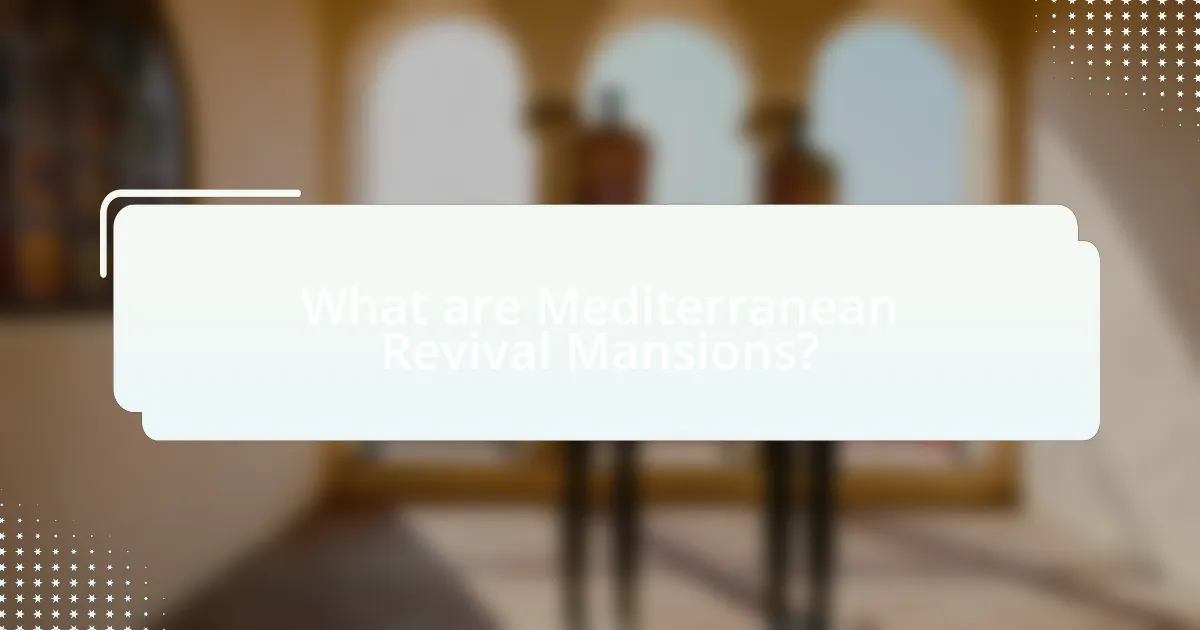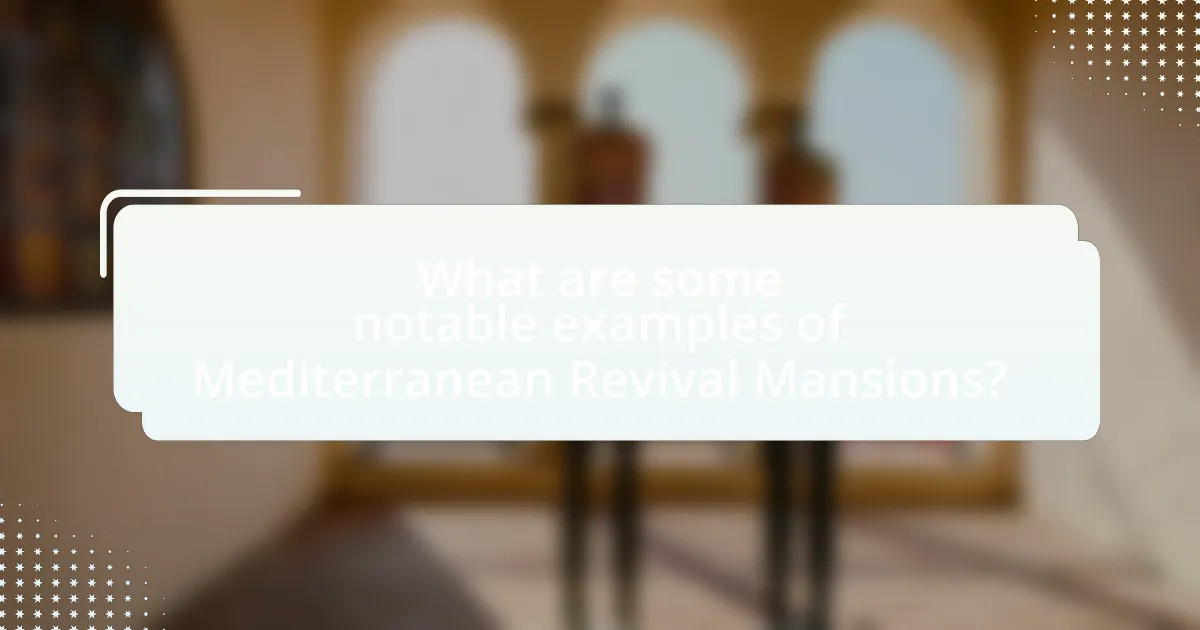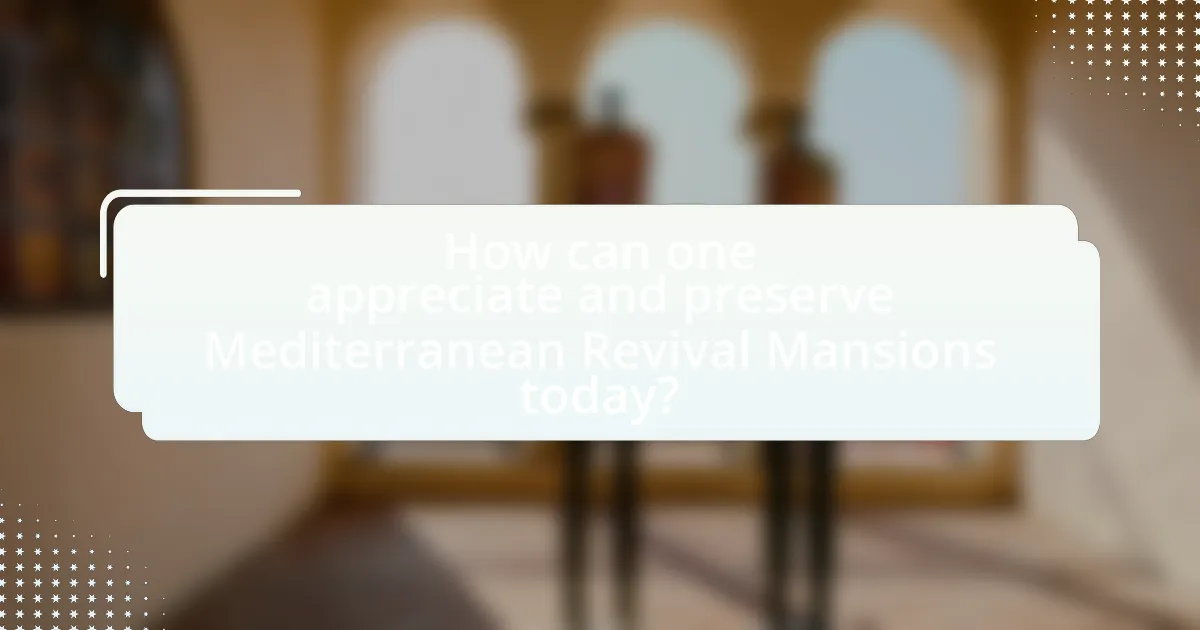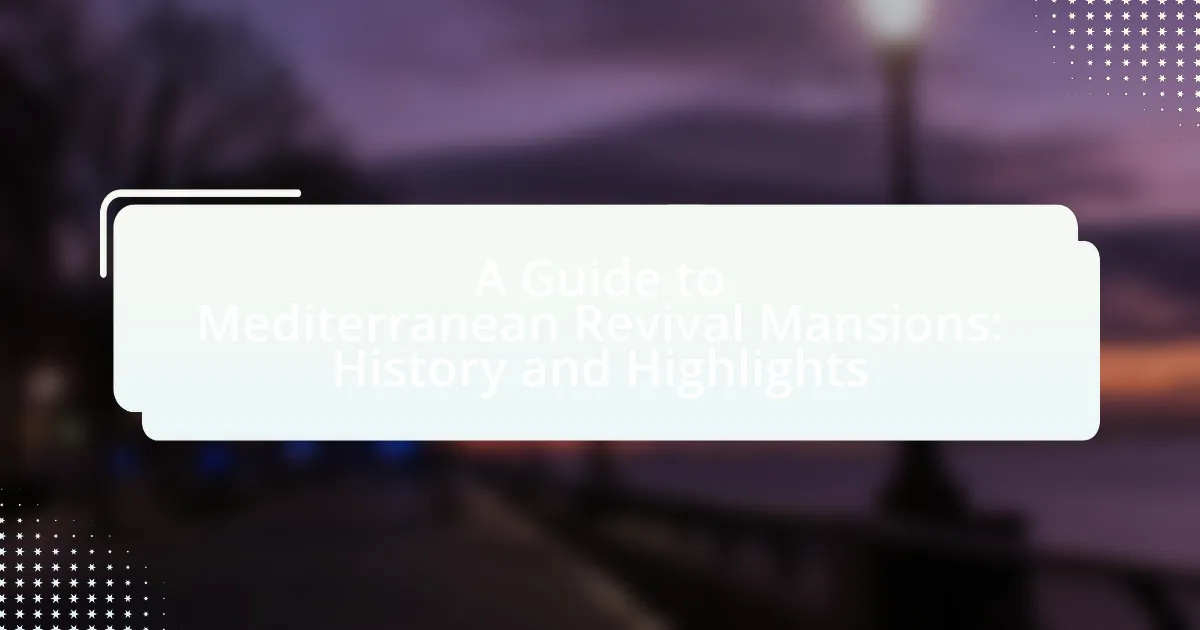Mediterranean Revival Mansions are large residential structures inspired by the architectural styles of Mediterranean countries, particularly Spain, Italy, and Greece. This article provides a comprehensive overview of the Mediterranean Revival style, detailing its origins, key characteristics, and historical influences that shaped its development in the early 20th century, particularly in the United States. It highlights notable examples such as Hearst Castle and Villa Vizcaya, discussing their architectural features and cultural significance. Additionally, the article addresses the challenges of preserving these mansions today and offers resources for those interested in Mediterranean Revival architecture.

What are Mediterranean Revival Mansions?
Mediterranean Revival Mansions are large residential structures inspired by the architectural styles of Mediterranean countries, particularly Spain, Italy, and Greece. These mansions typically feature stucco exteriors, red-tiled roofs, arched doorways, and ornate detailing, reflecting a romanticized interpretation of Mediterranean architecture. The style gained popularity in the United States during the early 20th century, particularly in coastal areas like California and Florida, where the climate mimicked that of the Mediterranean region. Notable examples include the Hearst Castle in California and the Biltmore Estate in North Carolina, which showcase the grandeur and elegance characteristic of this architectural movement.
How did the Mediterranean Revival style originate?
The Mediterranean Revival style originated in the late 19th and early 20th centuries as a response to the eclectic architectural movements of the time, particularly in the United States. This style drew inspiration from the architecture of Mediterranean countries, especially Spain, Italy, and Morocco, characterized by features such as stucco exteriors, red-tiled roofs, arched doorways, and wrought-iron details. The movement gained popularity as architects sought to create a romanticized version of Mediterranean architecture that reflected the climate and lifestyle of coastal regions, particularly in California and Florida. The 1915 Panama-California Exposition in San Diego significantly influenced the style’s spread, showcasing buildings that embodied these Mediterranean elements and attracting widespread attention.
What historical influences shaped the Mediterranean Revival architecture?
Mediterranean Revival architecture was shaped by historical influences including the Renaissance, Moorish architecture, and the Italianate style. The Renaissance brought classical elements such as arches and columns, while Moorish architecture contributed intricate tile work and ornamental details. Additionally, the Italianate style influenced the use of stucco exteriors and terracotta roofs. These influences coalesced in the early 20th century, particularly in the United States, where architects sought to evoke the romanticism of Mediterranean coastal regions, leading to the distinctive features of Mediterranean Revival buildings.
Which regions are most associated with Mediterranean Revival Mansions?
The regions most associated with Mediterranean Revival Mansions are primarily California, Florida, and parts of the Mediterranean coast, particularly in Spain and Italy. California, especially in areas like Los Angeles and Santa Barbara, features numerous examples of this architectural style, which gained popularity in the early 20th century. Florida’s Palm Beach and Miami also showcase many Mediterranean Revival homes, reflecting the style’s adaptation to the subtropical climate. Additionally, the Mediterranean coast, with its historical roots in architecture, influenced the design elements seen in these mansions. The prevalence of this style in these regions is supported by historical developments in architecture during the 1920s, when the Mediterranean Revival movement flourished in the United States.
What are the key characteristics of Mediterranean Revival Mansions?
Mediterranean Revival Mansions are characterized by their stucco exteriors, red-tiled roofs, arched doorways, and wrought-iron details. These architectural features reflect the influence of Mediterranean styles, particularly from Spain and Italy, which became popular in the United States during the early 20th century. The use of expansive terraces, decorative tiles, and intricate moldings further enhances their aesthetic appeal, while large windows and open floor plans promote natural light and ventilation. Historical examples, such as the Casa Casuarina in Miami Beach, exemplify these characteristics, showcasing the style’s luxurious and romantic essence.
How do architectural elements define the Mediterranean Revival style?
Architectural elements define the Mediterranean Revival style through features such as stucco exteriors, red-tiled roofs, arched doorways, and wrought-iron details. These characteristics reflect the influence of Mediterranean architecture, particularly from countries like Spain and Italy, which emphasizes a harmonious relationship with the surrounding environment. The use of decorative tiles, expansive terraces, and intricate moldings further enhances the style’s aesthetic appeal, creating a sense of elegance and warmth. Historical examples, such as the Villa Vizcaya in Miami, showcase these elements, illustrating the style’s roots in early 20th-century American architecture and its adaptation of traditional Mediterranean forms.
What materials are commonly used in Mediterranean Revival Mansions?
Mediterranean Revival Mansions commonly utilize materials such as stucco, clay tiles, wrought iron, and natural stone. Stucco serves as the primary exterior finish, providing a textured surface that is both durable and aesthetically pleasing. Clay tiles are often used for roofing, offering a distinctive Mediterranean look while being effective in shedding rainwater. Wrought iron is frequently incorporated in railings, gates, and decorative elements, adding elegance and security. Natural stone, including limestone and marble, is used for flooring and architectural details, enhancing the luxurious feel of these homes. These materials collectively reflect the architectural style’s emphasis on warmth, texture, and a connection to the Mediterranean region’s historical building practices.
Why are Mediterranean Revival Mansions significant in architectural history?
Mediterranean Revival Mansions are significant in architectural history because they represent a unique fusion of various historical styles, primarily inspired by the Mediterranean region’s architecture, which includes elements from Spanish, Italian, and Moorish designs. This architectural movement emerged in the early 20th century, particularly in the United States, where it became popular in coastal areas and affluent neighborhoods, reflecting the cultural aspirations of the time. The style is characterized by features such as stucco exteriors, red-tiled roofs, arched doorways, and elaborate wrought-iron details, which collectively evoke a sense of luxury and leisure associated with Mediterranean lifestyles. The significance of these mansions is further underscored by their role in shaping the identity of American architecture during the period, as they contributed to the broader Arts and Crafts movement and the development of regional architectural styles.
What role did Mediterranean Revival Mansions play in the cultural landscape of their time?
Mediterranean Revival Mansions served as symbols of wealth and cultural aspiration during the early 20th century, reflecting a fascination with Mediterranean aesthetics and lifestyles. These architectural designs, characterized by stucco exteriors, red-tiled roofs, and ornate details, emerged prominently in the United States, particularly in coastal areas like Florida and California. The style represented a departure from traditional American architecture, embracing influences from Spanish, Italian, and Moorish designs, which appealed to the affluent classes seeking to express their status and sophistication. The popularity of these mansions coincided with a broader cultural movement that valued leisure, travel, and the romanticized notion of the Mediterranean lifestyle, thus shaping the social fabric and architectural identity of the era.
How have Mediterranean Revival Mansions influenced modern architecture?
Mediterranean Revival Mansions have significantly influenced modern architecture by introducing elements such as stucco exteriors, red-tiled roofs, and arched doorways, which are now commonly integrated into contemporary designs. These architectural features, characterized by their emphasis on symmetry and ornamental detailing, have inspired modern architects to adopt a blend of traditional and innovative styles, resulting in a more diverse architectural landscape. For instance, the use of open floor plans and indoor-outdoor living spaces in modern homes can be traced back to the spatial concepts popularized by Mediterranean Revival designs, which aimed to create harmonious living environments. This influence is evident in various modern residential projects that prioritize natural light and connection to outdoor spaces, reflecting the enduring legacy of Mediterranean Revival architecture.

What are some notable examples of Mediterranean Revival Mansions?
Notable examples of Mediterranean Revival Mansions include the Hearst Castle in San Simeon, California, and the Villa Vizcaya in Miami, Florida. Hearst Castle, designed by architect Julia Morgan, showcases a blend of Spanish and Italian Renaissance styles and was built between 1919 and 1947. Villa Vizcaya, completed in 1916, features a combination of Italian Renaissance and Baroque elements, reflecting the opulence of the era. Both mansions exemplify the grandeur and architectural details characteristic of the Mediterranean Revival style, including stucco exteriors, arched doorways, and elaborate gardens.
Which famous Mediterranean Revival Mansions should be visited?
Famous Mediterranean Revival Mansions that should be visited include the Hearst Castle in California, the Vizcaya Museum and Gardens in Miami, and the Biltmore Estate in North Carolina. Hearst Castle, designed by architect Julia Morgan, showcases opulent architecture and stunning coastal views, reflecting the grandeur of the era. Vizcaya Museum and Gardens, created by industrialist James Deering, features exquisite gardens and a villa inspired by Italian Renaissance architecture. The Biltmore Estate, built by George Washington Vanderbilt II, is the largest privately-owned home in the U.S. and exemplifies the Mediterranean Revival style with its intricate details and expansive grounds. Each of these mansions offers a unique glimpse into the luxurious lifestyle and architectural beauty of the Mediterranean Revival movement.
What unique features do these notable mansions possess?
Notable Mediterranean Revival mansions possess unique features such as intricate tile work, arched doorways, and expansive courtyards. These architectural elements reflect the influence of Mediterranean styles, characterized by their use of stucco exteriors, red-tiled roofs, and ornate wrought iron details. For instance, the use of colorful ceramic tiles often adorns fountains and staircases, enhancing the aesthetic appeal and cultural significance of these structures. Additionally, many of these mansions include large balconies and terraces that provide panoramic views, further emphasizing their connection to the surrounding landscape.
How do these mansions reflect the principles of the Mediterranean Revival style?
These mansions reflect the principles of the Mediterranean Revival style through their architectural features, which include stucco exteriors, red-tiled roofs, arched doorways, and wrought-iron details. The use of these elements is rooted in the desire to evoke the charm and warmth of Mediterranean coastal architecture, particularly from countries like Spain and Italy. For instance, the emphasis on symmetry and the incorporation of courtyards and terraces are characteristic of this style, promoting outdoor living and a connection to nature. Additionally, the decorative tile work and ornamental details often found in these mansions serve to enhance their aesthetic appeal, aligning with the Mediterranean Revival’s focus on artistry and craftsmanship.
What are the stories behind these iconic Mediterranean Revival Mansions?
The stories behind iconic Mediterranean Revival Mansions often reflect the cultural and architectural influences of the early 20th century, particularly in the United States. These mansions were inspired by the coastal villas of Spain, Italy, and other Mediterranean regions, characterized by stucco exteriors, red-tiled roofs, and ornate details. Notable examples include the Hearst Castle in California, built by newspaper magnate William Randolph Hearst, which showcases lavish interiors and expansive gardens, symbolizing wealth and opulence of the era. Another significant mansion is Villa Vizcaya in Miami, designed by James Deering, which integrates European art and architecture with lush tropical landscaping, representing the American elite’s fascination with European culture. These structures not only serve as architectural landmarks but also encapsulate the social history and aspirations of their time, reflecting the lifestyle and tastes of affluent patrons during the Mediterranean Revival movement.
Who were the architects and owners of these notable mansions?
The architects of notable Mediterranean Revival mansions include prominent figures such as Addison Mizner, who designed several iconic estates in Florida, and Bertram Goodhue, known for his work in California. The owners of these mansions often belonged to affluent families, such as the Flagler family, who commissioned Mizner’s designs, and the Hearst family, associated with Goodhue’s creations. These architects and owners played significant roles in shaping the architectural landscape of the Mediterranean Revival style during the early 20th century.
What historical events are associated with these mansions?
Mediterranean Revival mansions are associated with the early 20th-century architectural movement that sought to evoke the styles of Mediterranean countries, particularly Spain and Italy. These mansions often reflect the cultural and economic prosperity of the Gilded Age in the United States, where affluent individuals constructed grand homes as symbols of wealth and status. Notable historical events include the rise of the American elite during the 1920s, which led to a boom in luxury home construction, and the subsequent Great Depression, which halted many such projects. Additionally, the architectural style gained popularity during the 1915 Panama-California Exposition, which showcased Mediterranean influences and inspired further developments in residential architecture across the country.

How can one appreciate and preserve Mediterranean Revival Mansions today?
To appreciate and preserve Mediterranean Revival Mansions today, individuals can engage in restoration efforts that respect the original architectural features and materials. This includes using historically accurate techniques and materials, such as stucco finishes and tile roofing, which are characteristic of the style. Preservation organizations, like the National Trust for Historic Preservation, emphasize the importance of maintaining the integrity of these structures, as they reflect cultural heritage and architectural history. Furthermore, community involvement in local preservation initiatives can foster awareness and appreciation, ensuring that these mansions are valued and protected for future generations.
What are the best practices for maintaining Mediterranean Revival Mansions?
The best practices for maintaining Mediterranean Revival Mansions include regular inspections, appropriate cleaning methods, and climate-specific care. Regular inspections help identify issues such as water damage or structural integrity problems early, allowing for timely repairs. Appropriate cleaning methods, such as using non-abrasive materials for stucco and tile surfaces, preserve the aesthetic and structural integrity of these homes. Climate-specific care is essential, as Mediterranean Revival Mansions often feature materials like terracotta and stucco that can be sensitive to moisture and temperature fluctuations; thus, ensuring proper drainage and ventilation is crucial. These practices are supported by historical preservation guidelines that emphasize the importance of maintaining original materials and architectural features to uphold the mansion’s historical value.
How can homeowners preserve the architectural integrity of these mansions?
Homeowners can preserve the architectural integrity of Mediterranean Revival mansions by adhering to restoration guidelines that respect original materials and design elements. This includes using period-appropriate materials for repairs, such as stucco, tile, and wrought iron, which are characteristic of the style. Additionally, homeowners should consult historical preservation societies or experts to ensure that any renovations align with the mansion’s historical significance. Research indicates that maintaining original features, such as arches, columns, and decorative moldings, is crucial for preserving the architectural style, as these elements define the aesthetic and cultural value of Mediterranean Revival architecture.
What common challenges do owners face in maintaining these properties?
Owners of Mediterranean Revival mansions commonly face challenges related to structural deterioration, high maintenance costs, and compliance with preservation regulations. The unique architectural features, such as intricate stucco work and tile roofs, require specialized care, which can be expensive and difficult to source. Additionally, many of these properties are subject to local historic preservation laws that mandate specific restoration practices, complicating renovation efforts. According to the National Trust for Historic Preservation, maintaining historic properties often involves navigating complex legal frameworks and securing funding for necessary repairs, further complicating ownership.
What resources are available for those interested in Mediterranean Revival architecture?
Resources available for those interested in Mediterranean Revival architecture include books, online databases, architectural journals, and local historical societies. Notable books such as “Mediterranean Revival Architecture in America” by David Gebhard provide in-depth analysis and visual references. Online databases like the Historic American Buildings Survey (HABS) offer extensive documentation of Mediterranean Revival structures. Architectural journals, including the Journal of the Society of Architectural Historians, publish scholarly articles on the subject. Additionally, local historical societies often have archives and resources specific to regional examples of Mediterranean Revival architecture, enhancing the understanding of its historical context and significance.
How can one get involved in preservation efforts for Mediterranean Revival Mansions?
One can get involved in preservation efforts for Mediterranean Revival Mansions by joining local historical societies or preservation organizations dedicated to architectural conservation. These organizations often engage in advocacy, fundraising, and educational initiatives aimed at preserving such structures. For instance, the National Trust for Historic Preservation provides resources and opportunities for volunteers to participate in preservation projects, including those focused on Mediterranean Revival architecture. Engaging with community events, attending workshops, and contributing to fundraising efforts can also enhance involvement in these preservation initiatives.
What organizations focus on the preservation of Mediterranean Revival architecture?
Organizations that focus on the preservation of Mediterranean Revival architecture include the National Trust for Historic Preservation, the Florida Trust for Historic Preservation, and the California Preservation Foundation. These organizations actively work to protect and promote the architectural heritage of the Mediterranean Revival style, which emerged in the early 20th century and is characterized by its ornate details and use of stucco, tile, and arches. The National Trust, for example, provides resources and advocacy for historic preservation across the United States, while the Florida Trust specifically addresses the unique architectural heritage found in Florida, including Mediterranean Revival structures. The California Preservation Foundation similarly focuses on preserving California’s diverse architectural history, including Mediterranean Revival buildings.
What tips can enhance the appreciation of Mediterranean Revival Mansions?
To enhance the appreciation of Mediterranean Revival Mansions, one should focus on understanding their architectural features, historical context, and cultural significance. Recognizing elements such as stucco exteriors, red-tiled roofs, and arched doorways allows for a deeper appreciation of the style’s aesthetic. Additionally, studying the influence of Mediterranean climates on design choices, such as open courtyards and expansive terraces, provides insight into their functionality. Historical context, including the movement’s origins in the early 20th century and its connection to the Arts and Crafts movement, further enriches appreciation. Engaging with local preservation societies or attending guided tours can also deepen understanding and appreciation of these unique structures.

Leave a Reply